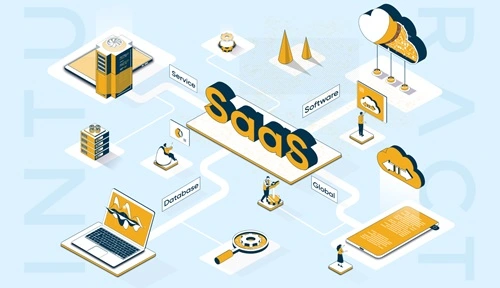Just a few years ago, the SAAS (Software As A Service) business model became super famous, and that was all thanks to some big companies or names that made it popular. Want examples of SAAS businesses in operation? Well, that would be Shopify, Wistia, MailChimp, Zoom, HubSpot, Adobe Software, etc. But in today’s time, all you need is a great idea to start with, and with the help of the SAAS business model, you can literally make a fortune. If you still want to weigh the pros and cons of it, then keep on reading this post because here we will share the advantages and disadvantages of the SAAS business model. Alright, here we go now.

Advantages of the SaaS Business Model
1. No Hefty Start-Up Fees
Probably one of the best things about the SaaS business model is that it is not only super easy to start or set up, but it also doesn’t require a whole lot of investment upfront, you know? This changes everything, especially for small businesses or new companies that are very careful with their money. Also, you don’t have to worry about how much it costs to manage your IT systems because the SaaS provider takes care of all that.
2. Set Up in a Snap
And want to know what’s the best thing with the SaaS business model, well, when you open a SaaS app, it’s ready to use because it’s in the cloud. Installing and setting up things took a long time in the past. We’re going to talk about quickly getting your tools ready to use. Because it was so easy to set up, businesses could get going right away without having to wait around any longer.
3. Hassle-Free Upgrades and Maintenance
Another major thing that makes SaaS literally one of the easiest business models is that you won’t need a whole team of IT experts to keep your software up to date. That’s up to the SaaS company. They make sure that the software always has the newest features and security patches, ALWAYS. Everything is done instantly, you know? Businesses don’t have to do anything to make sure they’re always using the most recent version.
4. Scale It Like You Mean It
SaaS can be adjusted to fit your needs, whether you need to grow (scale it up like crazy fast) or scale back. You can easily change your payment plan to fit your needs, scale up when you’re growing, and scale down when you’re cutting costs, and yes, that’s the very reason why businesses that have to deal with changing customer needs will love it.
5. Work from Anywhere
As long as you have an internet link, you can use your SaaS apps. This is great for teams that work from home or have members in different countries. No matter where they come in from, everyone stays on the same page and gets work done right away.
6. Steady Cash Flow
Regular payments that you can count on? Please say yes! Because SaaS is based on subscriptions, companies can plan their budgets without any surprises. That simply means you can save money with this steady stream of income, and buyers will also like it.
7. Customer Retention is Awesome
When a company gets used to a SaaS product, switching to a different one feels like a huge task. Why bother? If it works well with your business, it makes sense to stick with it. It is not like a Netflix subscription where you binged your favorite TV and now you are done with the subscription. Get it?
Disadvantages of the SaaS Business Model
1. You’re Not in the Driver’s Seat
Think about it for a sec though, when you’re using SaaS, the software is totally in the hands of the provider. This means you’re stuck with their update timeline, unable to tweak or dodge updates, even the ones you never asked for or wanted. For businesses that like their software tailor-made, this can be a real buzzkill.
2. Security and Privacy? It’s a bit of Gamble
Here’s the thing with SaaS: your data is out there in the cloud. And we assume that you are well aware of that, right? Well, this exposes you to all sorts of privacy headaches and security risks. Sure, most SaaS providers really level up their security, but let’s be real, the threat of data breaches is never off the table. So, simply put, companies that handle sensitive info need to weigh this risk very carefully.
3. No Internet, No Work
Access to SaaS apps totally depends on your internet connection. If it’s sluggish or drops out, say goodbye to smooth software performance. Worse still, during an outage, you might as well not have the software at all. This can throw a wrench in your business operations when you least expect it, you know?
4. Expect Some Lag
See, since everything is online with such a business model, it would be better if you count the lag thing when running the operations. You know, sometimes it happens where your internet speed is slow, or maybe the cloud setup is being a bit laggy because of the backend problems. These are all real scenarios and they happen more often than you think, so, be prepared for those as well. If there’s any network lag or bandwidth issues, your app performance takes a hit, which might not fly for every business.
5. Patience Required
Deciding to jump on a new SaaS platform, especially for B2B, isn’t quick. Why? Well, it’s a long road filled with demos, bargaining, and tons of evaluations by potential users. This isn’t just a drag, it eats up loads of time and resources for the SaaS provider.
6. Dog-Eat-Dog World (Competition)
The SaaS playground is packed with a lot of players, to be honest. New businesses in the scene can jump in any time, armed with shiny new toys that might outdo yours. Staying ahead of the game means never stopping the grind, innovating, marketing smartly, and delivering stellar customer service. Slip up, and your market share slips away. Simple as that.
Conclusion
That’s all for today. You see if you really want to start a business of your own, then you should definitely give the SAAS business model a try. If you have a solid business idea to work with, then you are pretty much good to go.

